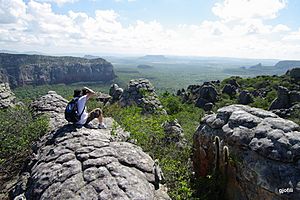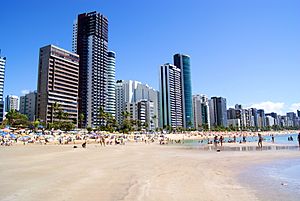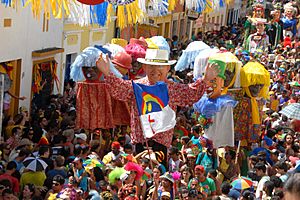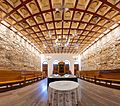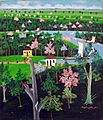Pernambuco facts for kids
Quick facts for kids
State of Pernambuco
|
|||
|---|---|---|---|
|
|||
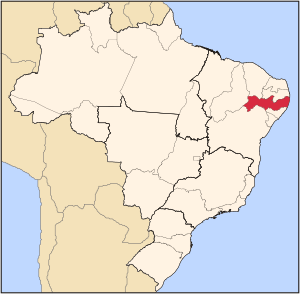
Location of State of Pernambuco in Brazil
|
|||
| Country | |||
| Capital and Largest City | Recife | ||
| Area | |||
| • Total | 98,311.616 km2 (37,958.327 sq mi) | ||
| Area rank | 19th | ||
| Population
(2012)
|
|||
| • Total | 8,931,028 | ||
| • Rank | 7th | ||
| • Density | 90.844077/km2 (235.285079/sq mi) | ||
| • Density rank | 6th | ||
| Demonym(s) | Pernambucano | ||
| GDP | |||
| • Year | 2007 estimate | ||
| • Total | R$ 32.255.687 (10th) | ||
| • Per capita | R$ 4.337 (21st) | ||
| HDI | |||
| • Year | 2005 | ||
| • Category | 0.718 – Low (23rd) | ||
| Time zone | UTC-3 (BRT) | ||
| • Summer (DST) | UTC-2 (BRST) | ||
| Postal Code |
50000-000 to 56990-000
|
||
| ISO 3166 code | BR-PE | ||
| Website | pe.gov.br | ||
Pernambuco is a state in Brazil. Its capital city is Recife. About 8 million people live in Pernambuco. Around 1.5 million of them live in Recife.
The state's economy mainly relies on agriculture. Its main exports are sugar cane and manioc. Pernambuco has a mostly tropical climate.
Contents
Exploring Pernambuco's Geography
Pernambuco has three main land areas. There is a narrow coast near the ocean. Then, there is a high plateau further inland. In between these two, there are slopes and terraces.
The land is shaped by old plateaus that have worn down. This has left steep cliffs and flat-topped mountains. These mountains are called chapadas. Some chapadas form borders with other states. These include the Serra dos Irmãos with Piauí and the Serra do Araripe with Ceará.
Coastal and Middle Zones
The coastal area is very fertile. It used to be covered by thick forests. These were part of the Atlantic Forest of eastern Brazil. Now, this area has many sugar cane farms. The climate here is hot and humid. Ocean winds help to cool it down a bit.
The middle area is called the agreste region. It has a drier climate. The plants here are lighter. Many trees lose their leaves during the dry season.
Inland and Island Areas
The inland region is called the sertão. It is high, rocky, and dry. This area often suffers from long dry periods. The climate has hot days and cool nights. There are two clear seasons: a rainy season from March to June, and a dry season for the rest of the year. The sertão is mostly covered by thorny scrub plants called caatinga. The São Francisco River is the main water source here.
The climate is milder in some parts of the countryside. This is because of the Borborema Plateau. Some towns are over 1,000 meters (3,280 feet) above sea level. Temperatures there can drop to 10 °C (50 °F) in winter. In some cities like Triunfo, it can even reach 5 °C (41 °F).
The island of Fernando de Noronha is also part of Pernambuco. It is in the Atlantic Ocean, about 535 km (332 miles) northeast of Recife. It joined Pernambuco in 1988.
Pernambuco's Rivers
Pernambuco has many rivers. Some small streams flow south to the São Francisco River. These include the Moxotó and Pajeú. They are often dry for much of the year.
The largest rivers in the east flow to the Atlantic Ocean. The Goiana River drains a rich farming area in the northeast. The Capibaribe River flows about 300 miles (480 km) to the Atlantic at Recife. Other important rivers are the Ipojuca River and the Uná.
Festivals and Celebrations
Carnival Fun

The four days before Lent are carnival time in Brazil. Everyone, rich or poor, celebrates in the streets. Pernambuco has huge Carnival parties. They feature frevo, a special music style from Pernambuco. Another famous Carnival music is maracatu.
The cities of Recife and Olinda have very lively Carnival celebrations. The biggest Carnival parade in Brazil is Galo da Madrugada. It happens in downtown Recife on Carnival Saturday. Another famous event is the Noite dos Tambores Silenciosos (Night of the Silent Drums).
Recife's Carnival is known across the country. It brings in thousands of people every year. The party starts a week before the official date. Music groups play in the Boa Viagem district.
On Friday, people dance to frevo, maracatu, and other music styles. There are many stages around the city with local and national artists.
A big highlight is Saturday. Over one million people follow the Galo da Madrugada group. From Sunday to Monday, the Night of the Silent Drums takes place. Here, Maracatus groups honor enslaved people who died.
Saint John's Day Festivities
Festa Junina (Saint John's Day) was brought to Brazil by the Portuguese. For them, Saint John's Day on June 24 is a very old and popular celebration. In Brazil, these parties happen during the tropical winter.
The celebrations usually start after June 12. They last until June 29, which is Saint Peter's Day. During these days, there are bonfires, fireworks, and folk dancing. People dress up in peasant costumes. They enjoy special foods like canjica and pamonha.
Saint John's Day is celebrated all over Pernambuco. The biggest parties are in Caruaru. Festivals in Gravatá and Carpina are also very popular.
Winter Festival Fun
In the hilly areas of the state's interior, temperatures can get cool in winter. They can reach 8 °C (46 °F). Every winter, tourists visit cities like Garanhuns, Gravatá, and Triunfo.
The city of Garanhuns holds an annual Winter Festival in July. It features concerts, dances, and local food. The cooler weather is also a big draw for visitors.
Images for kids
-
Olinda - UNESCO World Heritage Site
-
Kahal Zur Israel Synagogue in Mauritsstad (Recife), the first synagogue in the Americas
-
Atlântico Sul Shipyard, the biggest shipyard in the Southern Hemisphere, located in Industrial Port Complex of Suape.
-
Carnival in Recife
-
Guararapes International Airport, in Recife
-
Praia Sancho, beyond this beach, a reserve for some 600 spinner dolphins is established in Fernando de Noronha Archipelago, Pernambuco.
-
The neighborhood of Boa Viagem, in Recife
-
Palácio do Campo das Princesas in Recife, headquarters for the state Governor
-
The São Francisco river, in Petrolina, in the Sertão
-
Bolo de Rolo, a Pernambucan specialty
See also
 In Spanish: Pernambuco para niños
In Spanish: Pernambuco para niños






